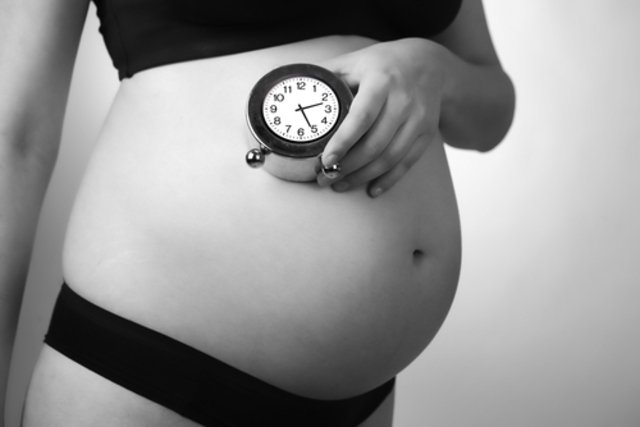Pregnant women diagnosed with gestational diabetes have a greater risk of suffering premature birth, induction of labor and even losing the baby, due to their excessive growth. However, these risks can be reduced by keeping blood sugar levels properly controlled throughout pregnancy.
Pregnant women who keep their blood sugar under control and who do not have babies weighing more than 4 kg can wait until 38 weeks of gestation for the spontaneous start of labor, and can have a natural birth, if this is their wish. However, if it is proven that the baby weighs more than 4 kg, the doctor may suggest a cesarean section or induction of labor at 38 weeks.
Gestational diabetes is characterized by an intolerance to carbohydrates that occurs, for the first time, during pregnancy, and there are more associated risks if it occurs during the first trimester of pregnancy.

Risks for the mother
The risks of childbirth in gestational diabetes, which can occur in pregnant women, may be:
- Prolonged normal birth due to poor uterine contractility;
- Need to induce labor with medication to initiate or accelerate normal labor;
- Laceration of the perineum during normal birth, due to the size of the baby;
- Urinary tract infection and pyelonephritis;
- Eclampsia;
- Increase in amniotic fluid;
- Hypertensive disorders;
Furthermore, after giving birth, the mother may also experience a delay in starting breastfeeding. Find out how to solve the most common breastfeeding problems.
Risks for the baby
Gestational diabetes can present risks to the baby during pregnancy or even after birth, such as:
- Birth before the expected date, due to the rupture of the amniotic sac before 38 weeks of gestation;
- Decreased oxygenation during childbirth;
- Hypoglycemia after birth;
- Abortion at any time during pregnancy or death shortly after birth;
- Hyperbilirubinemia;
- Birth weighing more than 4 kg, which increases the risk of developing diabetes in the future and of suffering any changes to the shoulder or fracture of the clavicle during natural birth;
Furthermore, children may suffer from obesity, diabetes and cardiovascular disease in adulthood.
How to reduce the risk
To reduce the risks of gestational diabetes, it is important to keep blood glucose under control, checking capillary blood glucose daily, eating correctly and exercising, such as walking, water aerobics or weight training, about 3 times a week.
Some pregnant women may need to use insulin when diet and exercise are not enough to control their blood sugar. The obstetrician, together with an endocrinologist, can prescribe daily injections.
Learn more about treating gestational diabetes.
What is postpartum like with gestational diabetes?
Immediately after birth, blood glucose should be measured every 2 to 4 hours, in order to prevent hypoglycemia and ketoacidosis, which are common during this period. Normally, blood glucose normalizes postpartum, however, there is a risk that pregnant women will develop type 2 diabetes in around 10 years if they do not adopt a healthy lifestyle.
Before discharge from hospital, the mother’s blood glucose level must be measured to check whether it has returned to normal. Generally, oral antidiabetics are discontinued, but some women need to continue taking these medications after giving birth, after an evaluation by a doctor, so as not to harm breastfeeding.
The glucose intolerance test should be carried out 6 to 8 weeks after birth, to check whether blood glucose levels remain normal. Breastfeeding should be encouraged because it is essential for the baby and because it helps with postpartum weight loss, insulin regulation and the disappearance of gestational diabetes.
If blood glucose levels remain under control after birth, the healing of the cesarean section and episiotomy occurs in the same way as in women who do not have gestational diabetes, however, if the values do not return to normal, healing may take longer.
Bibliography
- PAN AMERICAN HEALTH ORGANIZATION – MINISTRY OF HEALTH – BRAZILIAN FEDERATION OF GYNECOLOGY AND OBSTETRICS ASSOCIATIONS – BRAZILIAN DIABETES SOCIETY. Treatment of Gestational Diabetes Mellitus in Brazil. 2019. Available at: <https://www.diabetes.org.br/profissionais/images/pdf/Consenso_Brasileiro_Manejo_DMG_2019.pdf>. Accessed on June 22, 2020

Sign up for our newsletter and stay up to date with exclusive news
that can transform your routine!
Warning: Undefined array key "title" in /home/storelat/public_html/wp-content/plugins/link-whisper-premium/templates/frontend/related-posts.php on line 12
Warning: Undefined array key "title_tag" in /home/storelat/public_html/wp-content/plugins/link-whisper-premium/templates/frontend/related-posts.php on line 13





